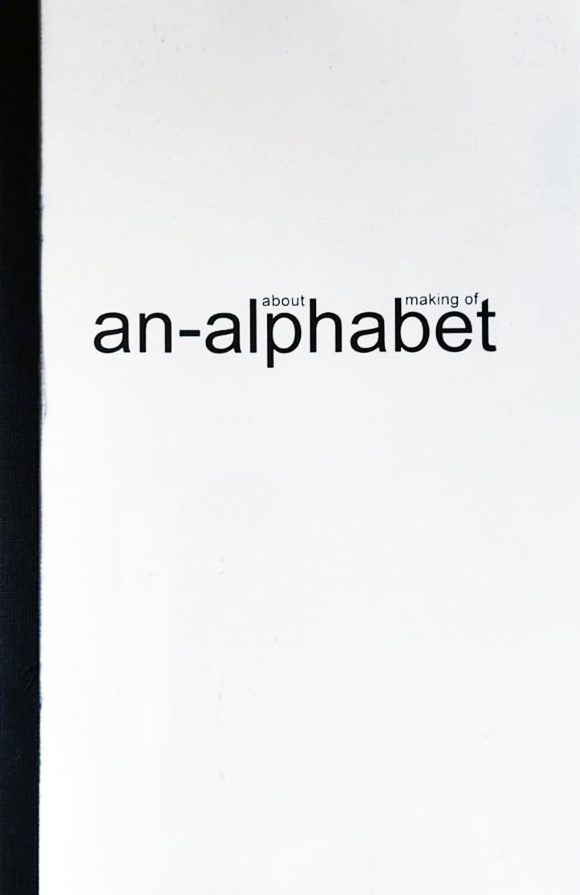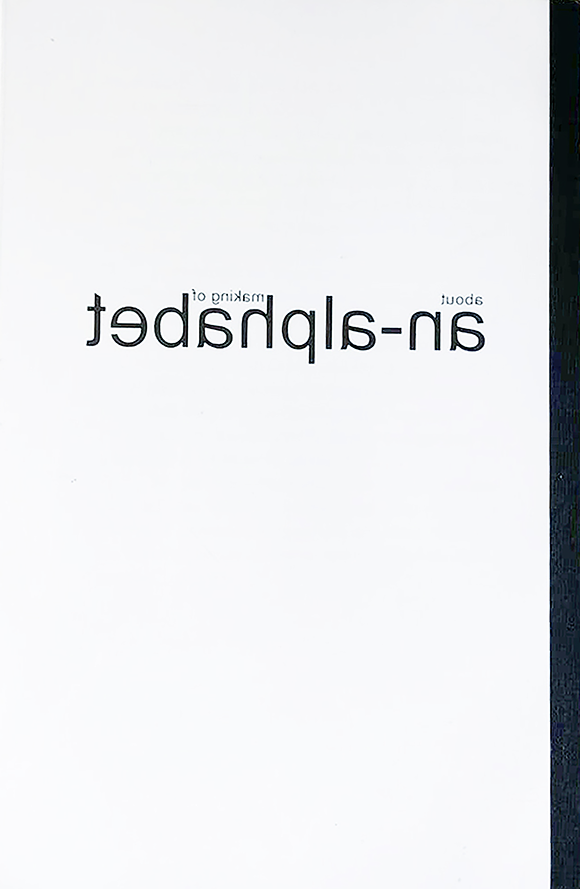an-alphabet
I compiled all student responses that were created with the anonymous survey in the winter course in Human Subjects and put them in an alphabetical order, and thus creating a product called an-alphabet, as through its bilingualism, terms popped up on different places, meaning the same, subverting the order. The challenge was to make ground for experiences and research and thus allow new avenues for knowledge production under lockdown restrictions.
about an an-alphabet
An alphabet arranges the elements of a language in a non-logical order and leaves the distances between each element undefined. It is a non-metric structure that includes all characters of a language. The combination of the characters enables the formation of words, meanings, and communication.
The an-alphabet can be read as a concatenation of “an” and “alphabet”. In English, the two connected words mean “an alphabet.” In German, the word also refers to an opposite meaning: the “Analphabet” is a person who does not know the alphabet. In English, on the other hand, this is called illiteracy. Thus, ambiguous and contradictory readings and connotations arise, oscillating between the terms alphabet and an-alphabet. This questionable title provisionally designates a construct of linguistic and artistic contributions by 103 first-semester students of the winter semester 20/21.
At the khb, teaching is bilingual (German/English) due to the inter-national share of students. In producing the overall alphabets, I have retained both languages in the original in order to preserve the content, sound, modes of articulation, and appearance of the individual contributions and the overall formation. The 103 student voices are not translated, otherwise adapted, or censored, but left in their original form (only typos have been corrected). The inclusion of two languages makes for an “unclean” use of the alphabetical order, since despite the formal adherence of the alphabetical structure, content crossings emerge, whereby bilingual terms that mean the same thing can appear in different places and thus subvert the ordering structure (e.g. Auge/eye, Gehirn/brain).
The alphabetical order of the contributions also led to surprising content collisions and transitions, making the an-alphabet readable as “random poetry.”
all 103 authors, students from WS 20/21 who contributed anonymously to the an-alphabet
Akhil Amer – Alec Ross – Alena Bachmann – Alessia Wurst – Aletta Krietemeyer – Alice Kister – Alice Paupini – Alissa Marlen Epple – Alissa Schaaf – Alma Luise Rothacker – Amy Graves – Anna Beyer – Anna Maria Eigner – Anna Zachariades – Anna Wolf – Antonia Leonie Steinbrink – Araiké Severino Da Silva – Arthur Werner – Bar Esh – Bastian Schwenteck – Ben van Heyden – Charlotte Brandhorst – Clara Dietz Sarries – Cord Matheo Romahn – Diana Römer Duque – Edwin Huhn – Eileen Helm – Elena Mir Fakhraei – Flora Schliekmann – Franka Ilg – Haemin Jung – – Hannah Lucie Sammann – Hannah Corbaz – Hannes Berwing – Hiba Hammadeh Ghrer – Hyuntae Jung – Imad Alfil – Inyeong Song – Ivan Leon Modeß – Janin Radermacher – Jasper Reinsch – Jelisa Weber – Jihae Lee – Joanna Zvonar – Joe Kotteck – Johannes Seluga – Julia Rogosin – Karola Kulcsar – Kimberly Mareen Richter – Kira Bürmann – Kolja Gabin Richter – Kristian Jørgensen – Kseniia Apresian – Laura Lizama – Laurin Schuler – Lea Maria Scheere – Leo Joshua Schrewe – Leon Wegwerth – Leonard Neuberger – Lilly Drosch – Linus Vogt – Luan Jorge da Silva Caja – Lucia Schmitz – Lucille Küpferle – Luis Möcks – Luise Sonntag – Lunita-July Dorn – Magdalena Weber – Mahmoud Ismail – Maja Füspök – Manuel Leyrado – Marieke Herbst – Marisa Bayer – Marius Kurz – Mathilde Valfells – Minori Ouchi – Nathan Evans – Nhung Le Phuong – Nicolas Weiler – Noah Lübbe – Nurdeniz Gür‘eş – Pascal During – Paul Ohnersorgen – Paul Engelmann – Pau Mantel – Pauline Heitmann – Philippa Bowyer – Raffael-Lucca Fiedler – Ragna Tümpel – Renee Klaßen – Sewon Kim – Tara Mianji – Tess Jolie Schleifer – Theresa Schiebel – Valentin Schade – Victoria Fechtner – Victoria Götz – Dandan Wang – Yan Chmarau – Yasmin Herrera – Yewon Seo – Zoe Maurischat
an-alphabet intro
From the student’s viewpoints, the project Human subjects thematizes the pandemic state of emergency with its imponderables, restrictions and intensification of social inequalities, which has significantly determined and still determines our lives. For teaching in online mode, my first concern was to dissolve the form of frontal teaching, in which a lecturer distributes tasks or imparts knowledge in front of the virtual presence of „muted“ students. Rather, students in Human subjects should be the ones to determine their human subjects – namely their topics and contents. The decisions on the content and on the media of the contributions should lie with the students. The only framing for the contents was that they should refer to the year 2020 – a requirement intentionally defined broadly as to be able to include all conceivable perspectives. Thus, despite the formal restrictions, a space for lively discussions was generated in which a mutual first acquaintance and a joint artistic work could arise.
My task was to develop the structure and methods. From a prefabricated online survey form for quantitative surveys, I created a qualitative instrument with exclusively open questions and freely answerable response fields, which had the function of a mouthpiece. Responses were anonymous and could be in the form of terms, sentences, or short stories. They were arranged alphabetically and were the source material for joint discussions and the generation of the student
artistic contributions. I accompanied the productions in individual and group meetings until the presentation of all results. After the semester, I fused the 6 group alphabets, generated by 103 students, to one complete text body with the current working title an-alphabet.
The an-alphabet documents which the pandemic year 2020 from the students‘ point of view. It can be raw material for a qualitative analysis as well as a skeleton to which the more than 80 student artistic contributions are attached, thus transforming the an-alphabet into a rhizome. It is also available as footage for further student designs and transformations.
an-alphabet


The booklet includes bilingual information about the making of the an-alphabeth, the original survey questions and all answers.
To download the an-alphabeth, please click on the button below.
an-alphabet_page examples
an-alphabet_original_survey questions
Original-Fragen/original questions:
SURVEY
1) Bitte nenne einige Begriffe, für die du gern einen Betrag entwickeln würdest. Es können Themen, Ereignisse, Phänomene, Befindlichkeiten, Zustände,
Situationen und alles sein, was menschliche Verfasstheiten in 2020 beeinflusst hat. // Please name some terms for which you would like to develop a
contribution. They can be topics, events, phenomena, states, conditions, situations and everything that influenced human constitutions in 2020.
2) Hier kannst du uns wissen lassen, welche positiven oder negativen Ereignisse oder Erfahrungen dich persönlich im Jahr 2020 besonders betroffen
haben. Auch diese können Ausgangspunkt für einen Beitrag sein. // Here you can let us know which positive or negative events or experiences have particularly affected you personally in 2020. They can also be a starting point for a contribution.
3) Hier erproben wir einen weiteren Ansatz. Ausgehend von der Anatomie und Morphologie eines Körperteils können wir gesellschaftliche, kulturelle und
politische Implikationen entfalten. Körperteile können sein: menschliche Zellen, Gliedmaßen, Organe, Systeme oder Strukturen. Bitte nenne ein (oder
mehrere) Körper-Teil(e): // Here we are testing a further approach. Starting from the anatomy and morphology of a body part, we can develop social, cultural and political implications. Body parts can be: human cells, limbs, organs, systems or structures.
4) Hier ist ein Ort für Inhalte, die unabhängig vom Jahr 2020 ein wesentliches Thema für die menschliche Verfasstheit sind und zu denen du gern arbeiten willst. // Here is a place for topics, which are an essential subject for the human condition independent of the year 2020 and which you would like to work on.
5) Hier kannst du Missverhältnisse, Konflikte und Schieflagen benennen, für die Veränderungen dringend erforderlich sind. Auch hierzu können Ideen und Beträge entstehen. // Here you can identify disparities, conflicts and imbalances for which changes are urgently needed.
6) Hast du vielleicht schon eine konkrete Idee oder einen Vorschlag für einen Beitrag? Bitte notieren! // Do you already have a specific idea or a suggestion for a contribution? Please let us know!
7) Fragen, Vorschläge und Ideen zur Arbeitsweise oder zu den Inhalten können gern hier hinterlegt werden. // Questions, suggestions and ideas regarding
the working method or content can be submitted here.
SUBMIT SURVEY